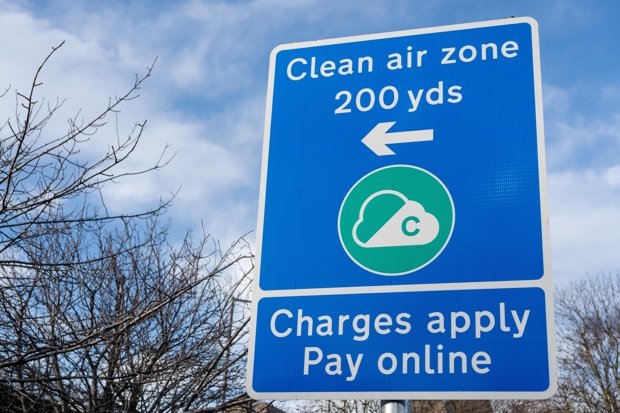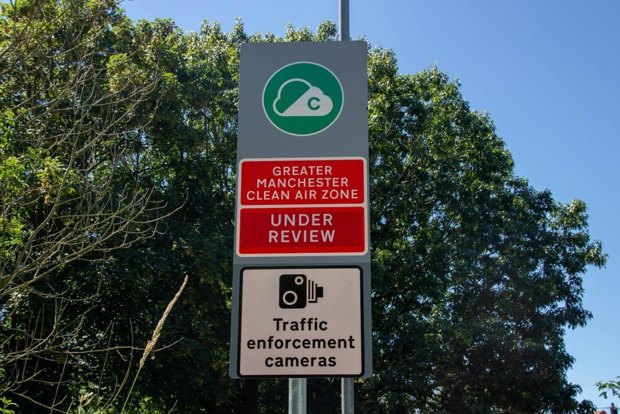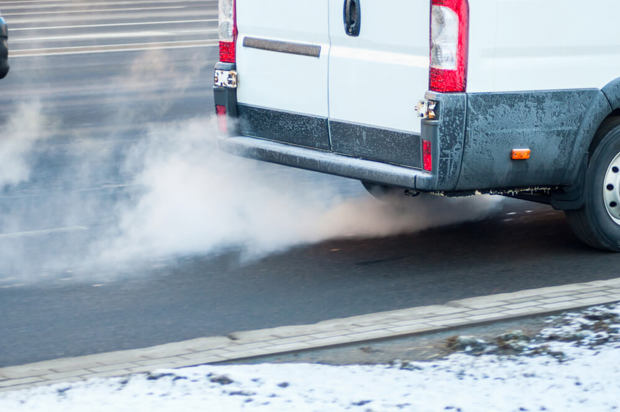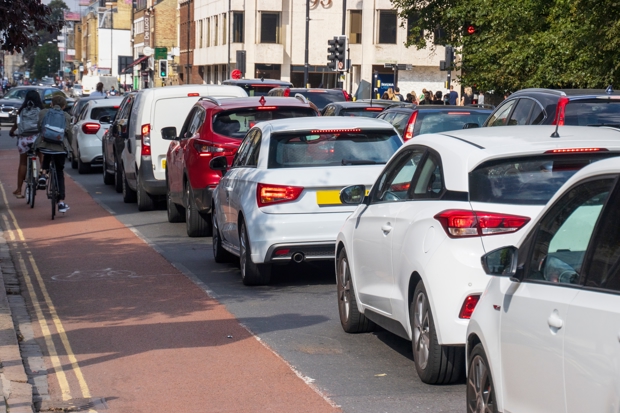UK Clean Air Zones: How they affect you
London's Ultra-Low Emissions Zone (ULEZ) is well-publicised but other cities' Clean Air Zone (CAZ) rules are inconsistent and confusing for motorists. Our guide clears the fog.

- What is a CAZ? We explain all
- Find out which UK cities have CAZ areas
- How will living near a CAZ affect you?
What are Clean Air Zones?
Road vehicles' emissions are one of the easiest, visible ways for governments to be seen to be tackling climate change and pollution. London’s LEZ and ULEZ is the most widely known example in the UK but other cities have adopted similar schemes called Clean Air Zones — CAZ for short.
It’s a pattern mirrored across mainland Europe and enabled through consistent EU emissions standards vehicles must comply with. Whether you’re driving in the Greater London area, major cities such as Bristol or Birmingham, or you’ve taken a trip across the channel to Germany or France, your car’s Euro-level emissions standard determines if you’ll be allowed to drive in certain areas without restrictions or penalties.
England's clean air zones are slightly different to London's ULEZ in that they are determined by local authorities and have four potential levels of scheme. Scotland's low emission zones are simpler, but are an outright ban on non-compliant vehicles. Scotland's approach to historic exemption might surprise fans of modern classics, though.
Aside from the capital, seven English cities and conurbations have CAZ schemes, two of which affect private car users, while in others the rules only apply to taxis and commercial vehicles — for now. Most English local authorities have considered, and dismissed the need for clean air zones. Consultation around emissions-based road-charging in Wales and Northern Ireland is ongoing.
Zero Emission Vehicles (ZEV) — such as fully electric cars — are fully compliant with all CAZ areas.
Clean Air Zones in England
In addition to London's ULEZ there are seven cities and conurbations in England with clean air zones, with Greater Manchester originally planned to be the eighth to implement one. Reduced pollution means that this is less likely to happen – and it's not the first scheme to have been abandoned.
Private car owners are only affected in two of these CAZ cities, with the rest applying to taxis, private hire vehicles, minibuses, buses, coaches, vans and HGVs depending on which band of scheme they’ve implemented.
| City or conurbnation | CAZ Band | Area of coverage (sq. miles) |
| Bath | C | 1.20 |
| Birmingham | D | 2.69 |
| Bradford | C+ | 9.60 |
| Bristol | D | 1.18 |
| Portsmouth | B | 1.16 |
| Sheffield | C | 0.90 |
| Tyneside (Newcastle & Gateshead) | C | 0.94 |
| Coming soon | ||
| Greater Manchester | On hold – January 2024 | TBD |
Following the precedent set by most emissions-based road charging compliance is determined by allowable nitrogen oxides (NOx) and particulates rather than carbon dioxide alone (CO2) which is used for Vehicle Excise Duty (VED) and Benefit-in-Kind (BiK) taxation. Some early hybrid models may not be compliant as a result.
The government clear air zone website allows you to check CAZ changes for your vehicle in all zones with one search.
The DVLA began recording emissions data on the V5 for new car registrations on 1 March 2001, though Euro standards began in 1992. V5 emissions data reflects the manufactured specification of that car including relevant options.
Cars registered before that date, and personal imports registered without official type approval documents regardless of age and Euro standard, will usually be non-compliant unless a certificate of conformity is obtained proving their CO2 and NOx levels meet Euro 4 for petrol and Euro 6 for diesel.
Adding to the confusion, two further English cities have unique schemes. Oxford operates a Zero Emissions Zone (ZEZ) on certain streets in its centre that is only applicable between 07:00-19:00. York has a CAZ that applies only to locally based bus operators.

Clean Air Zone bands in England
Compliance with Clean Air Zones in the UK (including ULEZ and LEZ) is based on the following EU emissions standards.
- Motorcycles and mopeds: Euro 3 — mandatory from January 2006
- Petrol cars and vans: Euro 4 — mandatory from January 2006
- Diesel cars and vans: Euro 6 — mandatory from Septmber 2015
- Large commercial vehicles: Euro VI — mandatory from December 2013
Although diesel-engined vehicles had to comply with Euro 6 standards from September 2015, some vans were given a 12-month exemption, remaining at Euro 5 level until September 2016.
Many manufacturers sold vehicles which complied with future legislation several years in advance of their implemenation. There are Euro 4-compliant petrol cars registered in the UK as early as 1999, while the earliest Euro 6 diesels were sold in 2012. Check the EU emissions level that's stated on your vehicle's V5 document.
When buying a used car or van it's safest to stick to newer registrations rather than the mandatory cut off date — and don't rely purely on the seller's word about a vehicle's emissions standard.
While those EU emissions levels determine the minimum required compliance levels across England's CAZ areas, each is subject to a further level of banding which means the rules apply differently across vehicle types and uses.
| CAZ Band | Vehicles affected | Number of current CAZ areas | ||||
| Private cars and motorcycles | Vans and minibuses | HGVs | Buses and coaches | Taxis and private hire vehicles | ||
| A | No | No | No | Yes | Yes | 0 |
| B | No | No | Yes | Yes | Yes | 1 |
| C and C+ | No | Yes | Yes | Yes | Yes | 4 |
| D | Yes | Yes | Yes | Yes | Yes | 2 |
If you drive a camper van whether coachbuilt, a factory-produced model or a home conversion, you'll be caught in the applicable class of commercial vehicle. Discounts or exemptions may be available varying by local authority, which is particularly relevant if you have a heavier, larger motorhome that would otherwise class as an HGV.
Bradford's Band C+ refers to an enhanced requirement for private hire vehicles. Petrol models should meet Euro 5 (including LPG and hybrid versions) if they are not wheelchair accessible.
Motorcycles can be included in the definition of private vehicles but no CAZ areas currently in force have chosen to include motorcycles in the scheme. The majority of non-historic models on the road meet Euro 3 minimum standards.
Paying to drive in England's Clean Air Zones
If you need to pay for using a non-compliant vehicle within a CAZ you will need to do so on each day you drive within it. If your vehicle is parked within a CAZ but does not move you should not be charged.
When visiting a CAZ-affected city and parking in public spaces or poorly lit side streets, be aware of the increased risk of plate theft or 'cloning', particularly if you've chosen a long-stay car park near an obvious transport hub and have a popular model and colour of car.
You can pay CAZ charges up to six days in advance of travel, on the day itself, or up to six days after without incurring a penalty charge. You may also register for an account to pay for regular trips. Payments are made through the government's Drive in a clean air zone website.
You will be issued with a penalty charge notice (PCN) if you miss the six-day deadline for payment. Penalty charge notices usually start at £60, with a 50% discount for payment within 14 days but check the details carefully if you receive a PCN.
CAZ and LEZ areas mean it's more important than ever to ensure you inform the DVLA of a change of keeper as soon as possible after a sale.
English Clean Air Zone charging exemptions
Some exemptions apply to non-compliant vehicles in English CAZ areas:
- Specialist vehicles — such as recovery vehicles, mobile platforms and similar
- Blue badge holders — based on disabled tax class although other exemptions may be available
- Historic vehicles — as per the VED definition of being at least 40 years old
- Vehicles undergoing telematics testing — such as assessment for route replacements
- Travel for medical reasons — to specific hospitals or facilities within a CAZ
The process for applying for an exemption needs to be done for each separate CAZ.
Local exemptions can tailor the charging to reflect the local population and businesses. These are usually time-limited and have to be applied for on a case-by-case basis:
- Discounted rate for large motorhomes — for coachbuilt, imported and larger A Class motorhomes with a gross vehicle weight over 7500kg, you may be able to get a reduction from the HGV rate that would normally apply.
- Community and school projects (not for taxi firms) — exemptions per trip may be applied for if an older vehicle needs to enter a CAZ.
- Historic commercial vehicles less than 40 years old — must not be used for hire or reward.
- Older Land Rover Defenders — a quirk of the system where some Defender Station Wagons with rear windows and up to nine seats were categorised by the DVLA as light goods vehicles, consequently incurring charges in Band C cities when ordinary private cars do not.

What is the Oxford Zero Emission Zone?
Not a Clean Air Zone and — so far — unique to Oxford the pilot Zero Emission Zone (ZEZ) operates between 07:00 and 19:00 on a number of central streets around Clarendon Centre, Ship Street and Bonn Square. Pay once, and you're covered for the active period for that day no matter how many trips you make through the ZEZ.
Unlike other CAZ areas Oxford has chosen a mixed approach to charging. Until August 2025 the highest rate of £10 is applied to the cars that don't comply with Euro 4 petrol and Euro 6 diesel emission standards – the same as other initiatives. However, vehicles that are compliant (LEVs) and not subject to charging elsewhere will also incur a fee, of £4.
Additional bands separating ultra-low and zero emission vehicles — ULEV and ZEV — mean only zero emissions vehicles can drive for free in the ZEZ. ULEV vehicles – those with four or more wheels and rated from 1-74g/km of CO2 – pay £2.
Two- and three-wheeled vehicles that aren't rated for 0g/km CO2 are subject to the same fee as ULEV vehicles regardless of level.
From August 2025 these rates double, with a minimum of £4 for ULEV and non-ZEVs with less than four wheels, £8 for LEVs meeting Euro 4 petrol/Euro 6 diesel standards, and £20 for non-compliant vehicles.
Exemptions follow the usual pattern, with local additions including students in financial hardship and hearses.
Clean Air Zones in Scotland
Scotland’s Low Emission Zones (LEZ) were introduced in 2018, starting in Glasgow for buses. Schemes to cover other vehicles including private cars in three additional cities were introduced from 2022, with residents given a grace period until June 2024 to allow them to change or upgrade their non-compliant vehicles.
Because the Scottish approach to regulation is to ban non-compliant vehicles from LEZ areas, it is very important to check your vehicle is compliant before driving in cities operating the scheme. Unlike CAZ or ULEZ, Scottish LEZ don't allow you to pay a fee to drive a non-compliant vehicle, you'll simply be issued with a penalty charge.
| City | LEZ information and vehicle check |
| Aberdeen | Aberdeen LEZ |
| Dundee | Dundee LEZ |
| Edinburgh | Edinburgh LEZ |
| Glasgow | Glasgow LEZ |
The emissions standards used for Scotland’s LEZ follow the same pattern as the rest of the UK with a key exception: All private hire vehicles and taxis whether petrol- or diesel-engined must meet Euro 6 emissions standards.

Scottish Low Emissions Zones: no pay-to-drive option
Unlike schemes in England and Wales the Scottish LEZ areas have no pre-payment option. You can't pay to drive in them — only be fined for doing so after the event.
If you drive a non-compliant vehicle within Scotland's LEZ, you will receive a £60 penalty charge notice (PCN), with a 50% discount for payment within 14 days.
Should you repeat the transgression within 90 days the charge doubles with each violation, up to a maximum of £480 for cars and £960 for buses, coaches and HGVs.
Scottish LEZ areas are determined by local authorities and may also include time-based exemptions. Check websites and signage carefully.
Scottish Low Emission Zone charging exemptions
Diverging from England's approach Scotland's discounts for disabled drivers go beyond the disabled tax class. Blue badge holders who are passengers in non-compliant vehicles and those in receipt of discounted VED due to qualifying for the mobility component of PIP may also apply for exemption from Scottish LEZ restrictions.
Some of those exemptions may need to be applied for on a per-trip basis.
.jpg?width=620)
Historic vehicle exemptions in Clean Air Zones
Across London’s ULEZ and England’s CAZ an historic vehicle is determined using the same rules as those for VED. This is where the 40 year-old historic taxation class is used to confirm the eligibility of such models. This means that a car that qualifies as a historic vehicle but has not had an application for a change of taxation class will still be charged.
Scotland has taken a different approach to historic vehicles, with a LEZ exemption for 30 year-old models — ten years younger than the rest of the UK. Modern classics registered as recently as 1995 are therefore exempt from charges in Scotland's LEZ areas.
So long as a car first registered in 1995 (for 2025) or older remains substantially unmodified and is no longer in production, it is considered an historic vehicle. There is no need to do anything to benefit from the 30-year historic exemption in Scotland — all vehicles that fit the criteria are automatically recognised.
In both cases, classic cars that have been modified or rebuilt with sufficient loss of originality that the DVLA has required an inspection or re-registration are likely to be charged.
Is there support for workers and businesses in Clean Air Zones?
Schemes are available to support businesses, workers and residents in CAZ areas who need to change a non-compliant vehicle. These include scrappage payments and public transport vouchers, grants for conversion of specialist vehicles to approved low-emission standards and credits for e-ccooters or cycle-to-work schemes.
Grants are generally determined by the local authority funding and prioritised on a need and use basis.
Should I avoid buying a used car that's not CAZ-compliant?
The expansion of London's ULEZ caused a near outcry, with many campaigners calling it a tax on low-income families and workers. This is a reality for some and it's one that local authorities such as Bradford have tried to take into account when implementing CAZ schemes.
Britain's used car market is not short of affordable Euro 4-compliant petrol cars and seasoned mechanics will have plenty of stories of poor reliability and expensive repairs associated with Euro 4 and 5 diesel cars. The very models that were sold new as a low-emission option – and attracted lower VED rates as an incentive – are the ones that after a decade of neglect and minimal maintenance ensured CAZ in cities became a necessity.
With a budget of less than £2000 — the amount of money that some local authorities will give you for scrapping a non-compliant car you already owned when the CAZ came into force — you can find many Euro 4 petrol cars in good condition in all shapes and sizes.
Chances are, the cost of refurbishing a DPF and EGR-bypassed, ECU-modded typical late-2000s diesel would also cost more than picking up a low mileage, full-service history 2015 model with a cleaner Euro 6 status.
If your non-compliant car is in exceptional condition and you want to keep it, it's worth considering the frequency of visits to CAZ areas and how much you may spend over the year compared with the price to change. Ten days will cost between £90 and £125.
In most cases CAZ areas offer park and ride facilities that cost less than the city centre parking and you can also consider options such as e-scooter rental or Uber to avoid taking your non-compliant vehicle into the zone.
It's definitely not worth selling your perfectly good non-compliant car if you merely live near a CAZ city and drive in once or twice a month.
If you really need to drive in a CAZ every day then it may be worth changing to a cheaper used electric car or hybrid.
Should used vans that aren't CAZ-compliant be avoided?
Outrage for van owners is rather easier to understand. The drop in value for vehicles that can't be used in certain cities is bad enough, on top of the cost of buying a van that is CAZ-compliant. Fortunately Euro 6 and VI compliant vans have been around long enough that most examples on the market will already meet the standards — at least, the ones you'd want to rely on every day.
Businesses have been given extra consideration by most councils and generous grants for conversions or upgrades are available to small businesses. If you have only one vehicle and you owned it before the CAZ came into force you'll maybe find a grace period or exemption applies.
Remember that your non-compliant but well-maintained van could have a market outside of CAZ cities. Low-mileage vans are still sought after by DIY and small business motorhome converters, particularly Volkswagen Transporters and Mercedes Sprinters.
Do clean air zones work?
There's some convincing evidence that clean air zones do work, both in terms of improving local pollution levels and in overall public health in cities and towns. When emissions reduction schemes were first proposed, most councils and authorities were considering schemes. By the deadline for zones to come into force most locations had already reached the necessary target for pollution levels simply though natural cycles of car replacement. This moved the average vehicle on the road closer to the cleaner exhaust emissions required for new cars and commercial vehicles.
It's worth remembering that by 2023, new HGVs, buses and coaches had been built to Euro VI standards for a decade, and the earliest Euro 6 diesel models were halfway through their average lifespan; at the time the proposals were drawn up, a large number of older vehicles were still on the road.
Notably, two CAZ schemes were planned and dropped because of this improvement. Southampton found that its own clean air plans based on local public transport were sufficient. Despite much of the infrastructure being installed and ready to go Leicester also found that enforcing a planned clean air zone was not necessary. Nottingham and Derby also chose to alter traffic flow and restrictions, rather than use emissions-based charging.
The success of these measures against pollution is demonstrable and a welcome benefit of what some may feel is more pressure on the motorist. While the current level of scheme appears set to stay for a while, the introduction of Euro 7 standards (expected to apply in 2028) may give environmentalists a new goal.
